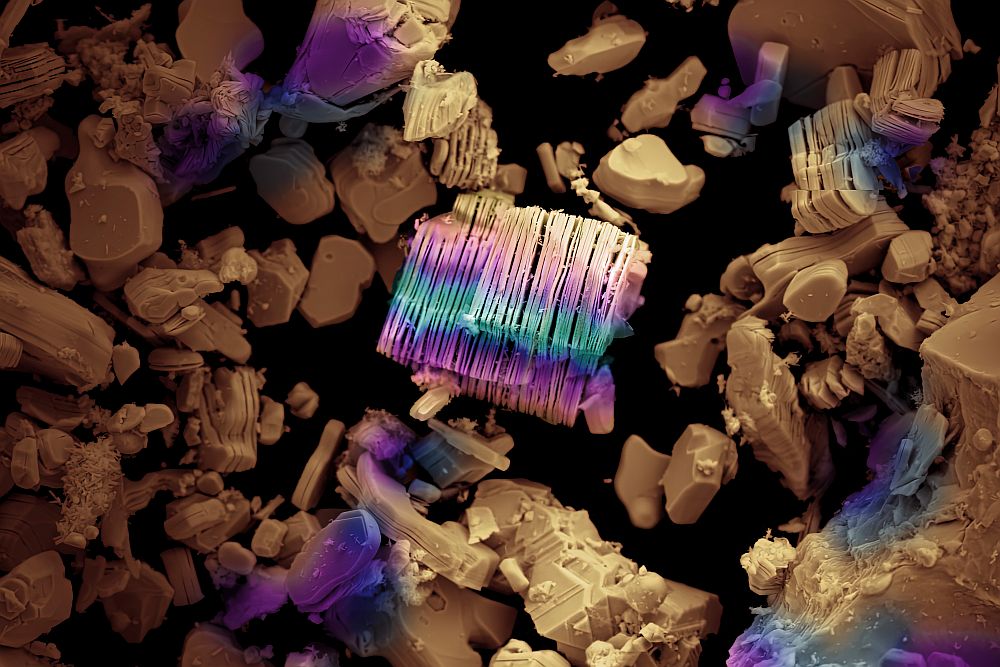
[Image above] The ratio of rough and smooth nanoparticles in a suspension influences how it increases in viscosity. Credit: Chiao-Peng Hsu; ETH Zurich
Surface roughness of particles may sound like a boring topic.
And maybe to some it is. But it’s also a topic that has really important implications for a wide variety of everyday materials that literally shape our world—perhaps most notably cement.
Cement is one of the most widely used building materials, but it also has some well-known issues when it comes to sustainability. Making, shipping, and building with cement consumes a lot of energy, materials, and resources and also creates a lot of greenhouse gases—not good when our planet and population are already in a rather precarious state.
Some researchers are innovating in big ways to help improve cement and its image. But even small changes also can help improve the sustainability of cement when you consider the sheer volume of the material used around the globe.
But back to those particles—the surface roughness of individual particles within a particulate material (like cement) is an important consideration because that roughness determines friction between the particles. And friction determines how well the particles can move past one another within the material—it determines flow.
Particles with smoother surfaces can more easily glide past one another, while rougher particles generate friction between them, impeding their ability to squeeze and slide past one another.
And when a suspension of rough particles encounters a large sudden force, a sufficiently high level of friction between the particles can cause it to behave like a solid—that, my friend, is a non-Newtonian fluid.
When a non-Newtonian fluid experiences a sudden large force, its particles jam together due to friction, causing the material to behave like a solid.
And now, researchers from ETH Zurich have precisely studied how the surface roughness of particles affect this behavior of particulate materials.
“We demonstrate the existence of a direct link between particle topography, nanoscale friction, and macroscopic discontinuous shear thickening,” the authors write in a paper describing the work, published in the Proceedings of the National Academy of Sciences USA.
The team created a library of silicate particles—resembling those tasty Haribo berry gummies—and varied the particles’ surface roughness to determine how it affected viscosity of a suspension of those particles.

Haribo berry gummies…mmmm, science!

Nanoparticles…mmmm, science! Credit: Chiao-Peng Hsu; ETH Zurich
Their results show that engineering the surface roughness of particles in a suspension directly impacts how that material thickens in response to force, opening the possibility of tuning a suspension by controlling its particles’ surface roughness.
For example, the team’s results show that less rough particles are needed to achieve the same results on suspension viscosity as many more smooth particles—suggesting that such tuning strategies could help reduce the amount of material in engineered suspensions.
And mixing both smooth and rough particles together in certain proportions can achieve some of the desired characteristics of each.
“It’s like mixing up ball bearings and gearwheels,” Lucio Isa, a professor at ETH Zurich and senior author of the new study, says in an ETH Zurich press release. “The gearwheels link together relatively easily to create a stable chain, but the ball bearings easily break those chains and enable flow.”
To examine friction at the individual particle level, the team also used atomic force microscopy to painstakingly measure how surface roughness impacts a particle’s friction response. The scientists affixed a 0.5-µm silicate particle to the cantilever arm of an atomic force microscope, which allowed them to measure how much the arm tilted due to friction as they moved the particle across a rough surface.
“Working with this kind of particle on a cantilever was extremely difficult, since the dimensions are incredibly small,” lead author and doctoral student Chiao-Peng Hsu says in the release. “We were the first group to accomplish this.”
However, although the scientists’ results provide shed some important light on the links between rheology and tribology, the translation into actual applications is still further down the road, according to the researchers. “Our goal was to investigate the ways in which we can change nano- and microstructures in order to influence material behaviour on a macroscopic level, and we succeeded,” Isa adds in the release.
However, this basic science could eventually help design better performing cements suitable for particular applications, Isa adds. “By adjusting the surfaces of granules and mixing them into cement in a similar way to our experiment, one could optimize cement’s flow characteristics.”
The paper, published in Proceedings of the National Academy of Sciences USA, is “Roughness-dependent tribology effects on discontinuous shear thickening” (DOI: 10.1073/pnas.1801066115).
Did you find this article interesting? Subscribe to the Ceramic Tech Today newsletter to continue to read more articles about the latest news in the ceramic and glass industry! Visit this link to get started.
Author
April Gocha
CTT Categories
- Basic Science
- Cement
- Construction
- Nanomaterials
Related Posts
The urban fabric of brick—Part 2: Ancient brick history
October 28, 2025


